Garlic mustard
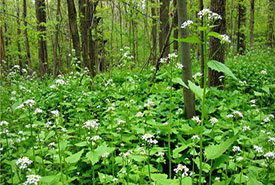
Invasive garlic mustard can take over forests, harming native understory species (Photo by NCC)
No friend to our forests
Garlic mustard, a highly invasive plant, has been spotted on Nature Conservancy of Canada (NCC) properties across Ontario.
Brought to North America in the 1800s, this invasive alien plant is now spreading across the continent at a rate of 6,400 square kilometres per year — that's an area 10 times the size of Toronto!
The success of garlic mustard is multi-faceted. Aside from having no natural enemies in North America, garlic mustard is an early riser. It takes advantage of the open canopy of springtime deciduous forests and the first rays of sunlight after the winter snow has melted, getting a head start on the native plants. Garlic mustard can change a forest's composition over time, creating a more favourable environment for itself, while driving other species out of the understory. This can even impact what trees grow in the forest, as garlic mustard can interfere with the germination of tree seeds.
In Ontario, garlic mustard occurs in the southern and eastern parts of the province and as far north as Thunder Bay.
What is garlic mustard?
Identification
- Garlic mustard leaves emit a strong garlic odour when crushed.
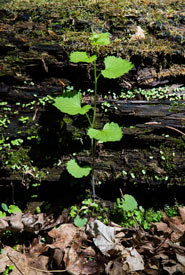
Garlic mustard, Happy Valley Forest, ON (Photo by Miguel Hortiguela)
- First-year plants have small, scalloped kidney-shaped leaves.
- Second-year plants grow up to 1.2 metres tall, with triangular, toothed leaves and clusters of small white flowers in spring (April-May).
Impacts of garlic mustard
- Garlic mustard rapidly spreads to displace native wildflowers and tree seedlings.
- The roots release chemicals that interfere with vital fungi growth needed for native plants to access nutrients, changing the soil composition and making it more difficult for native plants to grow.
Control options
- Hand pulling (make sure to get the whole root) in early spring (April/May) or fall (late September/October).
- Mowing/cutting in May (after flowering but before setting the seeds) and repeat until end of the growing season.
- Clipping flower heads in May and repeat until the end of the growing season.
- Repeated control may be needed for several years. Seeds can survive for up to 30 years in the soil!
- Planting native species in disturbed soil will help reduce future garlic mustard invasions.
What is NCC doing?
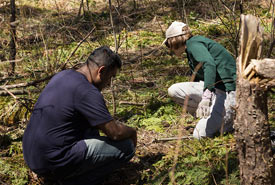
Volunteers pulling garlic mustard at Severn Woodland Nature Reserve, ON. (Photo by Nicole Evelyn Senyi)
Removal of garlic mustard is one of our most important and time consuming stewardship activities. Each spring and fall, NCC hosts regular Conservation Volunteers events that aim to eradicate this invasive species. Volunteers spend the day helping remove garlic mustard in some of Ontario’s most important, and beautiful, natural spaces. At the end of the day, participants make pesto from the invasive herb. In 2018, 135 volunteers helped to pull more than 100 garbage bags (approximately 13,000 litres) of this pungent plant.
Central Ontario
In the Minesing Wetlands, NCC staff are working to eradicate garlic mustard to protect Hine’s emerald dragonfly habitat. Garlic mustard reduces the quality of habitat for this species by crowding out the native vegetation they need to thrive.
Among the older-growth trees in Happy Valley Forest, NCC hosts spring and fall Conservation Volunteers events and works with local partners and neighbours to minimize the spread of garlic mustard and other invasive species. Staff are also working to assess the invasion at a landscape scale in order to prioritize the most important areas, generally the interior of the forest, to focus our control efforts.
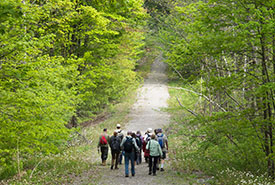
Volunteers heading out to pull invasive garlic mustard at a CV event in Happy Valley Forest (Photo by Miguel Hortiguela)
Along the eastern coast of Lake Ontario, NCC staff have been hand pulling garlic mustard from the edges of agricultural fields that are being restored to native grassland to create habitat for the at-risk bobolink. Although garlic mustard is mainly a forest plant, it can be quite persistent at the edges of forests. By removing the invasive plants before the restoration work starts, we minimize the chances of garlic mustard out-competing the native plants we are re-introducing to the fields.
Midwestern Ontario
NCC staff have been controlling garlic mustard in the Lower Maitland River Valley since 2017. Our focus has been on eradicating the plant from the mature, deciduous forests of the Blacker and Riverbend properties to allow native plants to re-establish, as well as within the restoration plots at the John and Marylo Graham Nature Reserve. Removing invasive species like garlic mustard from areas we are trying to restore is critical to the success of native plants taking root in these areas.
On the remote Cockburn Island, we are lucky that garlic mustard has yet to take firm hold. Each year, staff and local island stewards work diligently to remove garlic mustard along roads and ATV trails to prevent further spread on this amazing island.
Southwestern Ontario
In the southern part of the province NCC has been working much longer to control this invasive weed and we are starting to see results.
In the Southern Norfolk Sand Plain, NCC staff have been controlling garlic mustard at a large scale since 2013, focusing on over 600 hectares (1,482 acres) of restored meadow habitat, as well as Backus Woods, one of the best-remaining examples of Carolinian forest and home to many species at risk.
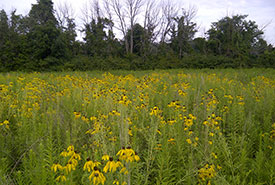
Recently restored field on Pelee Island, covered in grey-headed coneflower (Photo by NCC)
On Pelee Island we host a yearly event that sees about 20 volunteers from the Environmental Leadership Program at Catholic Central High School in London. When our control efforts first started on the Richard and Beryl Ivey property, it was a sea of garlic mustard plants. Today, there is a rocky forest with diverse native species like wild leek, mayapple, and Virginia waterleaf.
Alternative control methods
In order to look at alternative, and potentially more effective, methods of removal, NCC has teamed up with researchers from the University of Toronto who are studying potential biocontrol methods for garlic mustard. Biocontrol is the process of using other living organisms to control invasive species. A well-known example of this is the biocontrol of purple loosestrife, an invasive aquatic plant. In this case insects were used to feed on the purple loosestrife, halting its spread. While there are many opportunities with biocontrol, it is not always a straightforward or easy solution . The last thing scientists want is for another species to become invasive. That’s why biocontrol studies are very strictly monitored and can spend years being tested in labs before ever being used in nature.
What can you do?
Everyone can help to win the battle against alien invasive species. Here are some ways you can help:
- Plant native species in your garden, and if you have non-native plants, make sure they do not spread outside of your property.
- Treat infestations early to increase success
- Clean all gardening tools, clothing and shoes to limit the spread
- Sticking to designated hiking trails (pets too) to minimize the spread
- Attend an NCC Conservation Volunteers event and help remove this invasive plant from our natural habitats
- Donate to NCC’s Invasive Species program. To learn more, contact Jill Murray-Dimic at 1.800.465.0029 or Jill.murray-dimic@natureconservancy.ca




